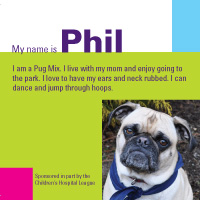With the pitter patter of small feet, Phil makes his way through the halls of Boston Children’s Hospital. He walks with a purpose, boarding the elevator that takes him to the oncology floor for his next appointment.

Phil is a new face in 6 North, the oncology unit at Dana-Farber/Boston Children’s Cancer and Blood Disorders Center. A spunky pug mix who knows a trick or two, Phil is one of nine therapy dogs who visit pediatric patients at Boston Children’s Hospital as part of the Pawprints Program. What he lacks in medical credentials and size, he easily makes up for in heart.
Therapy dogs like Phil play a meaningful role in the lives of children — from infants to teens — who are often hospitalized for extended periods of time, and may miss their pets from home. Visits from these furry friends provide just the dose of happiness many of these patients and families need.
“A lot of kids are very anxious, as they have many medical procedures,” says Laurel Anderson, MS, CCLS, child life specialist at Boston Children’s. “And just the thought that ‘there is a dog in the hospital to come see me,’ is just really incredible. The time with the dog draws smiles and laughter, and promotes a sense of calm.”
The Pawprints Program was created in 2003, and is managed by Aimee Lyons, RN, MSN, director of Nursing and Patient Services, Medical/Surgical Intensive Care Unit, Critical Care Transport Program, and Program Coordinators Maura Ammon, MSW, LCSW, and Kathryn Ruggeri, MSW, LCSW, at Boston Children’s, who are currently studying the effects of dog visitation on anxiety reduction.
Volunteers make the program possible, bringing their dogs to visit pediatric patients after the Pawprints Program staff screen, evaluate, and prepare the owner and dog teams for their roles onsite.
“The goal is to make sure the dogs are acclimated to the hospital setting and will enjoy working with patients,” says Ruggeri. “If the dogs are safe and happy, the kids will be too.”
Phil and the others make twice-monthly visits to patients’ rooms and the resource room, and can meet up to 10 children on any given day.
“It’s a good motivator for kids,” says Anderson. “Sometimes it can be really challenging for them to walk or to get out of bed, and the dog is an excellent — and sometimes the only — incentive to get up and move.”
The patients aren’t the only ones who enjoy these pups. “It’s a boost for the staff. Up here we have so much joy and hope, but it can be pretty challenging when you have such ill kids,” says Anderson. “It’s energizing for them to see the dog come through.”
And often, bonds between patients and dogs are formed through repeat visits. The kids look forward to the dogs, and will even collect their social calling cards like trading cards.
“The biggest thing is that it just helps them be a kid — a regular kid — and that’s one of our big goals here,” says Anderson. “When a child steps into a room with the dog, the hospital melts away and it’s just the child being happy and having a normal experience.”
Check out Bert, one of the Pawprints dogs, who was featured on the PBS Show Martha Speaks!

Such a great story!
This is such a great a idea! What a cute pug!
How could I register my dog to come in for a visit? Thank you.
Hi Tabetha,
Thanks for your interest in volunteering your dog! Dana-Farber’s visiting dogs are part of the Pawprints program, which is organized through Boston Children’s Hospital. Unfortunately, it looks as though the program isn’t accepting new pups right now, but here’s the info if you’d like to sign up for the future:
http://www.childrenshospital.org/patient-resources/family-resources/pawprints
You might also like to check out this site, which lists organizations across the state that are involved in dog therapy visits:
http://dogplay.com/Activities/Therapy/t_groups.html#MASSACHUSETTS
We hope this is helpful, and wish you the best.
DFCO